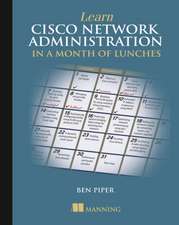Time-Varying Network Optimization: International Series in Operations Research & Management Science, cartea 103
Autor Dan Sha, C. K. Wongen Limba Engleză Hardback – 4 mai 2007
| Toate formatele și edițiile | Preț | Express |
|---|---|---|
| Paperback (1) | 329.76 lei 6-8 săpt. | |
| Springer Us – 25 noi 2010 | 329.76 lei 6-8 săpt. | |
| Hardback (1) | 336.21 lei 6-8 săpt. | |
| Springer Us – 4 mai 2007 | 336.21 lei 6-8 săpt. |
Din seria International Series in Operations Research & Management Science
- 20%
 Preț: 331.25 lei
Preț: 331.25 lei - 20%
 Preț: 570.61 lei
Preț: 570.61 lei - 18%
 Preț: 1132.02 lei
Preț: 1132.02 lei - 18%
 Preț: 773.72 lei
Preț: 773.72 lei -
 Preț: 170.39 lei
Preț: 170.39 lei - 17%
 Preț: 459.34 lei
Preț: 459.34 lei - 17%
 Preț: 360.47 lei
Preț: 360.47 lei -
 Preț: 263.40 lei
Preț: 263.40 lei - 24%
 Preț: 905.30 lei
Preț: 905.30 lei - 17%
 Preț: 460.08 lei
Preț: 460.08 lei - 17%
 Preț: 459.34 lei
Preț: 459.34 lei - 20%
 Preț: 631.58 lei
Preț: 631.58 lei - 13%
 Preț: 448.62 lei
Preț: 448.62 lei - 18%
 Preț: 738.28 lei
Preț: 738.28 lei - 18%
 Preț: 1225.94 lei
Preț: 1225.94 lei - 18%
 Preț: 948.92 lei
Preț: 948.92 lei - 18%
 Preț: 703.88 lei
Preț: 703.88 lei - 18%
 Preț: 957.44 lei
Preț: 957.44 lei - 15%
 Preț: 651.84 lei
Preț: 651.84 lei - 15%
 Preț: 641.03 lei
Preț: 641.03 lei -
 Preț: 404.29 lei
Preț: 404.29 lei - 18%
 Preț: 950.21 lei
Preț: 950.21 lei - 15%
 Preț: 649.06 lei
Preț: 649.06 lei - 18%
 Preț: 725.75 lei
Preț: 725.75 lei -
 Preț: 394.12 lei
Preț: 394.12 lei - 18%
 Preț: 951.47 lei
Preț: 951.47 lei - 15%
 Preț: 639.59 lei
Preț: 639.59 lei - 18%
 Preț: 773.06 lei
Preț: 773.06 lei - 18%
 Preț: 889.29 lei
Preț: 889.29 lei - 15%
 Preț: 655.60 lei
Preț: 655.60 lei - 15%
 Preț: 640.06 lei
Preț: 640.06 lei - 15%
 Preț: 583.93 lei
Preț: 583.93 lei
Preț: 336.21 lei
Preț vechi: 420.26 lei
-20% Nou
Puncte Express: 504
Preț estimativ în valută:
64.34€ • 66.77$ • 53.78£
64.34€ • 66.77$ • 53.78£
Carte tipărită la comandă
Livrare economică 18 martie-01 aprilie
Preluare comenzi: 021 569.72.76
Specificații
ISBN-13: 9780387712147
ISBN-10: 0387712143
Pagini: 244
Ilustrații: XVI, 248 p. 63 illus.
Dimensiuni: 155 x 235 x 19 mm
Greutate: 0.52 kg
Ediția:2007
Editura: Springer Us
Colecția Springer
Seria International Series in Operations Research & Management Science
Locul publicării:New York, NY, United States
ISBN-10: 0387712143
Pagini: 244
Ilustrații: XVI, 248 p. 63 illus.
Dimensiuni: 155 x 235 x 19 mm
Greutate: 0.52 kg
Ediția:2007
Editura: Springer Us
Colecția Springer
Seria International Series in Operations Research & Management Science
Locul publicării:New York, NY, United States
Public țintă
ResearchCuprins
Time-Varying Shortest Path Problems.- Time-Varying Minimum Spanning Trees.- Time-Varying Universal Maximum Flow Problems.- Time-Varying Minimum Cost Flow Problems.- Time-Varying Maximum Capacity Path Problems.- The Quickest Path Problem.- Finding the Best Path with Multi-Criteria.- Generalized Flows and Other Network Problems.
Recenzii
From the reviews:
"This monograph provides a unified framework for a series of models and algorithms to study flow optimization problems in time-varying networks. … the topics covered by this monograph make it useful for graduate students as a textbook and are of interest for engineers and researchers working on time-varying network optimization problems." (Francesc Comellas, Mathematical Reviews, Issue 2009 b)
"This monograph provides a unified framework for a series of models and algorithms to study flow optimization problems in time-varying networks. … the topics covered by this monograph make it useful for graduate students as a textbook and are of interest for engineers and researchers working on time-varying network optimization problems." (Francesc Comellas, Mathematical Reviews, Issue 2009 b)
Textul de pe ultima copertă
Network flow optimization analyzes optimization problems on networks; hence, network optimization is reflected in many application fields including transportation, telecommunication, computer networking, financial planning, logistics and supply chain management, energy systems, etc. However, to date, most network optimization problems that have been studied are static network optimization problems. But "real world networks" are time-varying in essence, and therefore any flow within a network must take a certain amount of time to traverse an arc. Moreover, the parameters of "real world networks" may change over time. Problems such as how to plan and control the transmission of flow becomes very important, because waiting at a node, or traveling along a particular arc with different speed, may allow one to catch the best timing along the path; thus, achieving the objective and changing the decision making process. It should be noted that there are a host of decision making problems in practice that should be formulated as optimization models on time-varying networks.
The express purpose of TIME-VARYING NETWORK OPTIMIZATION is to describe, in a unified and self-contained manner, a series of models, propositions, and algorithms developed in recent years on time-varying networks. References and discussions on relevant problems and studies that have appeared in the literature are integrated in the book. The book consists of eight chapters, in which the following problems are formulated and examined: (1) the shortest path problem, (2) minimum-spanning tree problem, (3) maximum flow problem, (4) minimum cost flow problem, (5) maximum capacity path problem, (6) quickest path problem, (7) multi-criteria problem, and (8) the generalized flow problem. The time-varying traveling salesman problem and the Chinese postman problem are presented in a chapter together with the time-varying generalized problem. While these topics will be described all within the framework of time-varying networks, our plan is to make each chapter relatively self-contained so that each can read separately.
The book will be useful for researchers, practitioners, graduate students and senior undergraduates, as a unified reference and textbook on time-varying network optimization. While the book describes the structure of the algorithms, the authors also have developed the software that implements the algorithms. This software can be made available for academic study purposes upon request.
The express purpose of TIME-VARYING NETWORK OPTIMIZATION is to describe, in a unified and self-contained manner, a series of models, propositions, and algorithms developed in recent years on time-varying networks. References and discussions on relevant problems and studies that have appeared in the literature are integrated in the book. The book consists of eight chapters, in which the following problems are formulated and examined: (1) the shortest path problem, (2) minimum-spanning tree problem, (3) maximum flow problem, (4) minimum cost flow problem, (5) maximum capacity path problem, (6) quickest path problem, (7) multi-criteria problem, and (8) the generalized flow problem. The time-varying traveling salesman problem and the Chinese postman problem are presented in a chapter together with the time-varying generalized problem. While these topics will be described all within the framework of time-varying networks, our plan is to make each chapter relatively self-contained so that each can read separately.
The book will be useful for researchers, practitioners, graduate students and senior undergraduates, as a unified reference and textbook on time-varying network optimization. While the book describes the structure of the algorithms, the authors also have developed the software that implements the algorithms. This software can be made available for academic study purposes upon request.
Caracteristici
Addresses two types of needs in the research of network optimization: 1) to present the latest research efforts and findings on time-varying network optimization; and 2) to examine key models and results on dynamic network optimization problems that can be used by academics, practitioners, and graduate students or senior-year undergraduate students There is a great need to seek optimal solutions on these types of time-varying networks. This has become particularly relevant and important in those complicated networks in the changing environments today, such as transportation networks, telecommunication networks, and the Internet – this book treats these problems The Ahuja, Magnati & Orlin Network Flows textbook for Prentice Hall (1993) is the single dominant book in the market; however, it treats only static network optimization flows. Cai et al is the first systematic treatment of time-varying models and algorithms in network optimization. As such, it will be a book of which the entire optimization community across the Applied Sciences will have considerable interest Includes supplementary material: sn.pub/extras

















